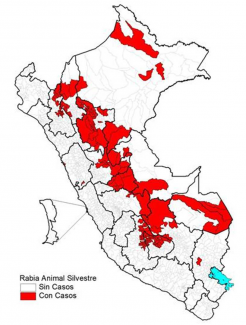Bat rabies outbreak in Peru claims one, but others survive: Mass vaccination campaign underway
- Community News
- Cases and responses
An alarming post in ProMED’s January 9th report described 85 suspected human rabies cases stemming from bat bites in Peru. This report was based on a story originally reported in English in Outbreak News Today that was in turn based on a Publimetro report written in Spanish. Further investigation of the news story revealed that the 85 suspected cases were actually 82 potential exposures to bat-transmitted rabies and just 3 clinical rabies cases, illustrating a common reporting error when writing about rabies outbreaks, which was most likely exacerbated by a computer-generated translation.
The 85 exposures occurred in December 2016 in the Cusco region, home of the UNESCO World Heritage Site, Machu Picchu. Dozens of potential exposures to rabies were reported in La Convención province, but of the 85 suspected of having contact with rabid bats, only three clinical cases have been confirmed at the time of this report. Other unverified reports of deaths possibly due to rabies are currently under investigation by Peruvian health officials.
Of the three rabies cases confirmed in humans, two were military personnel stationed in the area with their unit, and the other was a civilian–a two-year old girl. One soldier is still alive and recovering slowly, but one of the soldiers is now deceased. Additionally, the child is still alive although not yet in stable condition, but she has continued to survive after a month’s hospitalization. All of the remaining soldiers in the unit were sent to the military hospital in Lima for post-exposure prophylaxis (PEP), even though no bat bites were documented amongst them.
All three clinical cases were treated in Lima using the Milwaukee Protocol, an experimental therapy that involves medically inducing a coma to provide neuroprotection to patients with active clinical symptoms. That there were two rabies survivors is extremely rare and quite remarkable, although prognosis for a complete neurological recovery has typically not been favorable after survival from a full-blown rabies infection, which is usually 99.9% fatal.
The two infected soldiers were also given the anti-viral favipiravir, which was administered for the first time under special licensing from the US Food and Drug Administration (FDA) as a treatment for an active human rabies infection. Favipiravir (originally known as T-705) has been in Phase 3 clinical trials as a treatment for influenza, but because it is active against a broad range of RNA-based viruses, favipiravir is being trialed as an experimental drug for the treatment of rabies. The drug was obtained through the efforts of the Peruvian Military Hospital and the National Institute of Health in Peru, and the administration of the drug was overseen by Dr. Carol Epstein, Executive Vice President of Medi Vector, a US company that is managing favipiravir’s clinical trials.
In response to the outbreak, ProMED reports that Peruvian government has provided more than 912 civilians and 680 soldiers stationed in the Cusco region with PEP. A mass vaccination campaign to provide pre-exposure prophylaxis (PrEP) for rabies immunity to area residents is also currently underway.
La Convención province is deep in the Amazonian jungle and is home to vampire bats that serve as reservoirs of the rabies virus. The bats, which are also found in many regions in South America, typically feed on wildlife for their blood meal, but they can also target humans and livestock. Educating people living in bat-endemic areas about vampire bat-transmitted rabies has not been appropriately prioritized. Additionally, indigenous Peruvians living in insolated communities have little contact with government-sponsored health initiatives and are often not aware of the dangers of exposure to vampire bats nor have many campaigns been conducted to immunize these people against rabies. Bat-transmitted rabies has also been economically challenging for livestock farmers in the Amazon region due to the loss of non-immunized cows and sheep to bites from infected bats.
Summarized by Laura Baker, GARC, and Sergio Recuenco, UNMSM, Universidad Nacional Mayor de San Marcos , Lima, Peru, based on reports from ProMed); OutbreakNewsToday, “Peru: 85 suspected human rabies cases reported in jungle of Cusco”;Hospital Cayetano Heredia website, “Especialistas del Hospital Cayetano Heredia Confirman Caso de rabia silvestre en menor mordida por murciélago (Specialists of the Hospital Cayetano Heredia confirm a case of wild bat rabies in a minor)”; RPP Noticias, “Soldado mordido por murciélago en Alto Pichas murió en Hospital Militar (Soldier bitten by bats in Alto Pichas dies in Miliary Hospital)”; Andina, “Helicóptero del Ejército traslada a Arequipa restos de sargento fallecido por rabia (Army helicopter transports remains of sergeant killed by rabies to Arequipa)”; and Pressreader, “Muere sargento de la Policía mordido por un murciélago cuando patrullaba en el Vraem (Police sergeant who was bitten by bat while patrolling Vraem died).
